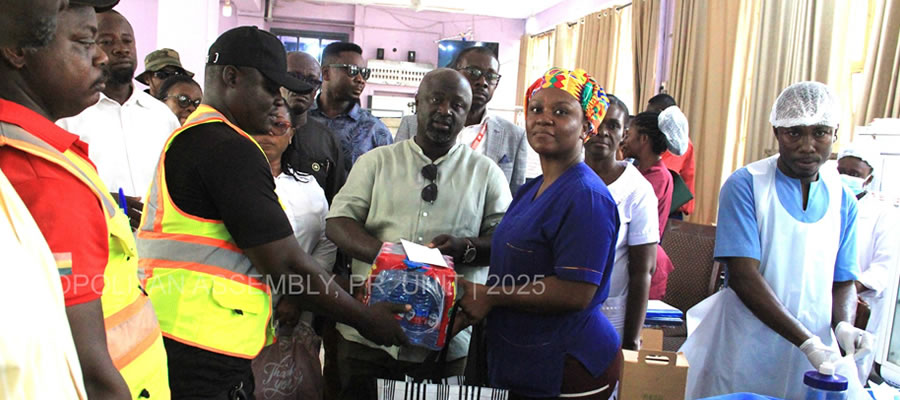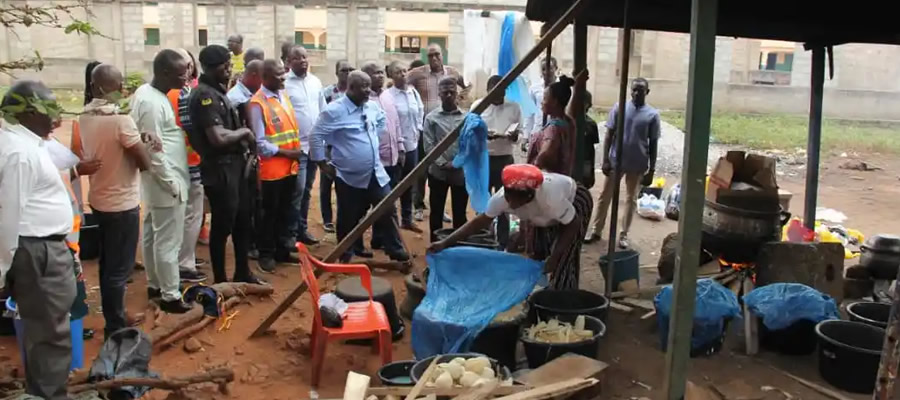

Introduction
Since human beings are the ultimate beneficiaries of the development plans, programmes and projects, it is imperative for planning to take cognizance of population dynamics of the metropolis.
Population Size and Growth Rates
The Kumasi metropolis is the most populous district in the Ashanti Region. During the 2000 Population Census it recorded a figure of 1,170,270. It has been projected to have a population of 1,625,180 in 2006 based on a growth rate of 5.4% p.a and this accounts for just under a third (32.4%) of the region’s population. Kumasi has attracted such a large population partly because it is the regional capital, and also the most commercialised centre in the region. Other reasons include the centrality of Kumasi as a nodal city with major arterial routes linking it to other parts of the country and also the fact that it is an educational centre with two State Universities, a Private University, a Polytechnic, two Teacher Training Colleges, Secondary Schools and a host of Basic Schools. Tables 2 and 3 give the size and growth patterns of Kumasi.
Ashanti Region is currently the second most urbanised in the country, after Greater Accra (87.7%). The large urban population in the region is mainly due to the fact that the Kumasi metropolis is not only entirely urban but accounts for a third of the region’s population. The growth of industries and the large volume of commercial activity in and around Kumasi as well as the high migrant number may account partly for the relatively high urban population. It has been estimated to have a daytime population of about 2 million. The population has grown rapidly over the inter-censal periods from 346,336 in 1970, 487,504 in 1984 to 1,170,270 in 2000. Based on these the census reports the estimated population growth rate as 5.47 per cent (Table 2 and 3).
Age and Sex Structure
The age and sex structure of the population are analysed in view of the fact that the development problems and needs of a population vary from one age group to the other. The age structure of the population in the metropolis is skewed towards the youth (2000 Population census). The highest proportions of the population are in the age cohorts 0 – 4 years (13.2%) and 5 – 9 years (12.4%). Cumulatively, 39.9 per cent of the population is below 15 years, in contrast to other districts, which range from 40 to 47 per cent. This may be an indication of a slow, incipient decline in fertility. There are more males (50.2%) than females (48.8%) in the metropolis.
Spatial Distribution
The population of the Central Business District comprising Adum, Asafo and Ashtown continue to reduce over the years. According to the census reports, Adum recorded 12,991 in 1970, 9,693 in 1984 and 8,016 in 2000. This is anticipated to further fall. On the other hand areas such as Ayigya, Dichemso and Tarkwa Maakro, which were small communities in 1960 and 1970, have grown into densely populated residential areas with 20,000 – 40,000 people. Areas comprising the CBD therefore continue to reduce in terms of human numbers whereas the population in the new developing areas increases. This is accounted for by the mere reason that residential accommodations in the former are being converted into commercial use.
Population Density
Ashanti Region has a relatively high population density of 148 per sq. km, having increased steadily from 45 persons per sq. km in 1960 and 61 persons per sq. km in 1970 to 86 persons per sq. km in 1984. The region’s population density was around the fifth in the country up to 1984, rose to the third densely populated region (148 per sq km) after the Greater Accra (895 per sq.km) and the Central Region (162 per sq. km) in 2000. The high density of population of the region may be explained by the fact that it has the second largest economy in the country after the Greater Accra Region, which tends to attract people from all walks of life to the region.
The Kumasi Metropolitan Area has a total surface area of 254 sq km (2000 population census) with a population density of 5,419 persons per sq. km. The Kumasi metropolis is second to the Accra metropolis (5,530).
Household Sizes/Characteristics
The average household size in Ashanti is 5.3 persons, the same as the Brong Ahafo. It is however lower than only the three Northern regions. The average household size in the Metropolis is 5.1. The average number of households per house is 3.4. This relatively large number of households per house is due largely to the large population in the metropolis.
Children constitute 34.0%, the highest proportion of household members in the metropolis. Several factors may account for this high proportion of children of household heads. In addition to minors who may still be living with their parents, there could also be children, particularly females, who might move to stay with their parents in accordance with tradition, during the latter part of pregnancy, well into the post natal leaning period, before returning to their spouses. Divorced, widowed, unemployed or even destitute children may fall back to live with their parents while sorting themselves out. All these are manifestations of the fallback support system that is the bedrock of the traditional family structure.
Other relatives form the second highest proportion of the population in households in the metropolis after children, constituting between 12.9% and 43.3%. The high proportion of other relatives in households in the metropolis is attributable to a number of socio-economic factors. The urban setting attracts people to come and stay with relatives whilst actively searching for jobs or their own dwelling units. The household size structure in the metropolis has been analyzed and the results are as presented in Table 5.
The results in Table 4 show a dominance of single person households in the metropolis. For instance, single households alone constituted 21.1% and 23.3% of all households in the metropolis in 1984 and 2000 respectively. Similarly, single households dominated with male single household heads constituting 16.8% as against 4.2% for females in 1984. The dominance of single person households, especially among the male population in the metropolis, could be attributed to a number of cultural, administrative and economic factors. Culturally, some Asantes who dominate all tribes in the metropolis often prefer living in separate houses from their families. Also, most immigrants who arrive in the city often leave their families behind until they are settled. On administrative grounds, the city being the regional capital has attracted a lot of officers.
Labour Force
The 2000 census results show that 76.9 percent of the population aged 15 years and older in the region is economically active. The proportion of the economically active population that is those who worked, for at least one day, in seven days prior to the census was 71.4% in the Kumasi metropolis. The proportion of the unemployed population in the Kumasi Metropolis is 16.0%. The unemployment rates are more pronounced in the metropolis than the remaining urban areas. This general trend is the same for both sexes and may be as a result of the high rural urban drift, apparently in search of non-existent jobs. Students form the highest proportion of those who are not economically active in the metropolis, whereas the aged together with the retired form a relatively high proportion.
Child Labour
According to the 1998 Children’s Act, children less than 13 years of age are not expected to work whilst those aged 13 – 15 years can only do light work. As established by the Ghana Child Labour Survey (Ghana Statistical Service, 2001) such children have to work in order to support the family mainly due to poverty.
The census results showed that about a tenth of children (8.7%) aged 7 – 14 years in Ashanti Region worked at least one day within the seven days prior to the census. In the Kumasi Metropolis, 5.5% to 16.4% of children aged 7 – 14 years worked during the period. In the Kumasi Metropolis, 49.9% of children in this age group worked in the wholesale and retail trade in the private informal sector.
Kumasi has been identified as a major transit point in the trafficking of child labour. The ILO/IPEC in collaboration with KMA are working assiduously to put in place mechanisms to stem the tide of the Worst Forms of Child Labour (WFCL) in the Metropolis. Ten (10) communities where the problem is most prevalent are being targeted. These are Asawase, Bantama/Race Course, Aboabo/Sawaba, Adum, Asafo, Dichemso, Anloga, Roman Hill/Railways, Akwatia Line and Moshie Zongo.
It also calls for the government and other Child Support Organizations to take advantage of the new data on working children to implement more effectively the projects and programmes intended to enhance the welfare of children. The project seeks to recognise and collaborate with the religious bodies, youth groups, child issues - related NGOs, Transport organizations, Night Guards, Restaurant Owners, Assemblymen and Opinion leaders
Migration Trends
Migration, one of the three factors of population change, is discussed in terms of place of birth, place of enumeration and the population born elsewhere (in or out of Ghana). About two-thirds (65.7%) of the population in the Ashanti Region were born where they were enumerated, the remaining one-third (34.3%) are immigrants to the region.
The strategic location of Kumasi and its status as a brisk administrative and commercial centre has made the city a destination of both internal and international migrants. The Metropolis attracts a number of migrants from several parts of Ghana and neighbouring African countries such as Togo, Burkina Faso, Mali, Nigeria, Ivory Coast and abroad especially, Europe. Table 7 shows the growth rate of the city’s population due to migration.
The results presented in Table 7 reveal that migration is a key contributing factor to the phenomenal growth of 60.8 percent and 53.1 percent of the city’s population growth in 1960 and 1970 respectively and again in 2000 48.6%. This has been projected to 57.4% and 56.7% in 2005 and 2009 respectively.
Rural - Urban Split
During the period 1960 – 2000, the region’s population distribution was transformed from three-fourth (75.1%) rural in 1960 to a little over half (51.3%) urban in 2000 (Population Census Report). This transformation was fastest during the period 1984 – 2000. The region is currently the second most urbanized in the country after Greater Accra.
The large urban population in the region is mainly due to the fact that the Kumasi Metropolis is not only entirely urban but accounts for a third (32.4%) of the region’s population. The growth of industry and the increase in commercial activities may, partly account for the high urban population.
It has however been estimated that 48%, 46% and 6% of the Metropolis are urban, peri-urban and rural respectively (Metro Agric. Directorate).
Date Created : 11/28/2017 3:25:34 AM












 facebook
facebook
 twitter
twitter
 Youtube
Youtube
 +233 593 831 280
+233 593 831 280 0800 430 430
0800 430 430 GPS: GE-231-4383
GPS: GE-231-4383 info@ghanadistricts.com
info@ghanadistricts.com Box GP1044, Accra, Ghana
Box GP1044, Accra, Ghana